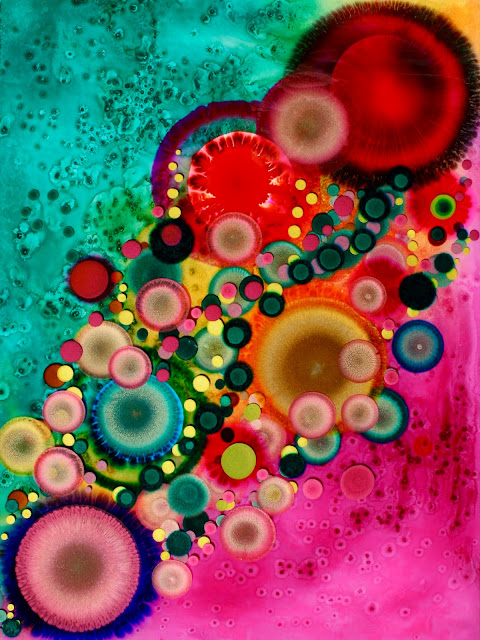Convergence
Available at Liquidambar
This blog post will be a little different than what I usually write.
Recently, several have commented on the use of circles in my paintings. They asked, "What do you call your style of painting? Does it have a name?"
Most comments were very positive, and they would explain why they are drawn to circles. A few asked if I can add straight lines. Some of my paintings have lines such as the one below, but circles seem to always be what one sees first.
Mystery of Locus
40"x30"x2"
I want to focus in this post on the use of circles in not only my paintings, but of circles in art throughout history. After thinking along the subject, I did a little online research.
I found a book and Facebook page of The Story of Circlism by Edward C. Stresino, the Father of Circlism. There is a blog post about Stresino as well which was a planned submission to Wikipedia. Another blog post claims that in 1985 Stresino discovered Circlism and others that make the claim that he is the Father of Circlism.
I remembered having read an article in an old magazine many years ago about Circlism, and had occasionally thought that my work might fit into that style. I also paint in what I consider an organic process using the properties of the inks and the method of application to make the circles on their own. I use no paintbrushes to make my circles so immediately felt that my art may be considered Organic Expressionism as well as Circlism. The strict definition as I see it though does not allow for my paintings to be considered Organic Expressionism.
A few weeks ago, I was going through some old issues of Horizon which were hardbound magazine-type books on art and culture. The September 1961 issue has an article about Circlism. The artist, Alexander Liberman, who was the former art director of Conde Nast publications, had called his style of art Circlism!
This is a photo of the article.
This is a photo of the painting that accompanies the article. If viewed in the book it vibrates.
Circles have been used since the caveman wrote on his walls, and since the Aborigines painted on their bodies and rocks up to 20,000 years ago. Since 1971, Aborigines have been known for their dot paintings which pre-dates 1985. Some African tribes have used dot paintings on their faces for hundreds of years.
Kandinsky was known for his circles in his paintings. Circles in a Circle shows Kandinsky's obsession with the circle as early as the 1920s. Although circles are featured prominently in many of Kandinsky's paintings, he was not the first to make them a featured element in his art. You can read a good article here about the subject.
If you wish to see some current Circlism art, check out the digital art of Ben Heine. You will be blown away. But remember this is digital art, and not the painstakingly mix of paint and application to a substrate. Nevertheless, it is probably the future of art, and I am a fan.
So where am I going with this blog post?
Circles have been a concept of man since he probably first looked up at the moon. To call oneself the Father of Circlism assumes much that can not be lived up to. I doubt if we can really call anyone the Father of Circlism.
NOTE ADDED 4/1/2019 To VM who commented below. Please read. Blogger has disabled commenting from my Google account so I cannot comment below.
VM, I do not quite understand what point you are trying to make. I am not a hater and neither do I feel the need to write anything except what I can back up with facts. Sorry if you found this disconcerting.
NOTE ADDED 4/1/2019 To VM who commented below. Please read. Blogger has disabled commenting from my Google account so I cannot comment below.
VM, I do not quite understand what point you are trying to make. I am not a hater and neither do I feel the need to write anything except what I can back up with facts. Sorry if you found this disconcerting.



